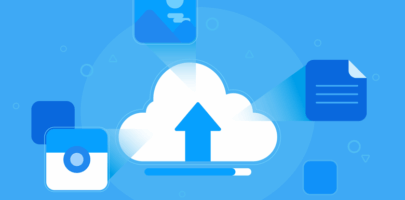- What Is Retail Marketing?
- The Importance of a Strong Retail Marketing Strategy
- Types of Retail Marketing
- 10 Key Retail Marketing Strategies & Examples
- How MarcomCentral’s Distributed Marketing Solutions Enhance Retail Marketing Strategies
Get news, updates, and insights delivered straight to your inbox.
10 Key Retail Marketing Strategies & Examples

Despite the meteoric rise of e-commerce, in-person shopping at a physical store still accounts for the majority of retail transactions. However, generating adequate foot traffic is getting harder because today’s consumers have more options than ever when shopping for products.
To stand out, brands need to ditch antiquated retail marketing strategies for modern alternatives that blend in-person and digital interactions.
In this comprehensive guide to retail marketing strategies, we explore how to create a dynamic online presence, drive sales, and improve profitability by creating holistic customer journeys. Our list of strategies includes real-world examples of brands that are winning in today’s ultra-competitive marketing environment.
What Is Retail Marketing?
Retail marketing refers to all of the strategies you use to raise awareness about your services or products and generate sales. Retail marketing content can include advertisements about your products, promotions, pricing, and sales. Your strategy can (and should) incorporate a variety of digital and brick-and-mortar tactics, including the following:
- Search engine optimization (SEO)
- Influencer marketing
- Word-of-mouth
- Content marketing
- Partnerships with other brands/retailers
- Point-of-sale ads
- Window displays
- In-store promotions
- On-site content
An effective retail marketing strategy combines these channels to create a holistic customer journey that spans multiple channels and touchpoints.
The Importance of a Strong Retail Marketing Strategy
Retail marketing is an incredibly competitive space. Retailers pay more for leads than most other industries but have average conversion rates of just 3% (Marketing Insights). Low conversion rates and high per-lead costs haven’t discouraged retail marketing spending, though. Last year, advertisers spent roughly $52 billion on retail media and are projected to increase spending by $10 billion in 2025, bringing the annual total to a staggering $62 billion (eMarketer).
Simply throwing money at your customer base isn’t going to produce sustainable results. That’s where a strong retail marketing strategy becomes invaluable. Knowing your audience and evaluating your market position are the first steps to creating a better strategy.
56% of adult consumers like shopping at brick-and-mortar stores and online (National Retail Federation). If your brand offers both options, you need a strategy that promotes each type of transaction. This means adopting complementary channels and customizing marketing materials for each audience segment.
Additionally, you’ll need a marketing strategy that is tailored to the unique needs of your business. The best retail marketing strategies are both scalable and flexible. Achieving this balance means adopting modern solutions. With MarcomCentral, brands can effortlessly manage an ever-growing number of assets while delivering consistent experiences at scale.
Types of Retail Marketing
Standing out in today’s competitive retail environment means using complementary retail marketing strategies. Some of the types of retail marketing tactics your brand should consider include:
Traditional In-Store Marketing
Traditional in-store marketing refers to tactics like placing pop-up signage in your store, upselling customers at checkout, and using store displays to notify visitors of current sales. You can also adjust the layout of your store to drive foot traffic to top-selling products and items with higher profit margins.
Traditional marketing strategies for retail stores are still relevant. E-commerce accounts for just 15.4% of U.S. retail sales (Statista), meaning in-person retail transactions drive 84.6% of revenue. In 2023 alone, retailers generated approximately $7.24 trillion in cumulative sales in the United States (Statista). There are more than 3.1 million retail trade stores (Statista) in the United States, many of which are thriving.
Here are a few reasons why approximately 57% of consumers prefer to shop at a physical store (Statista):
- Many customers appreciate the hands-on experience of shopping in-store
- Consumers prefer to touch, try on, and inspect items before spending their hard-earned money
- People who need items immediately will make the trip to a local retailer
- Some consumers want to avoid shipping costs and waiting periods
- Consumers prefer the attention and personal touch they receive during in-store customer service interactions
- They prefer the convenience offered by brick-and-mortar stores
- Some shoppers enjoy social interactions that are only available at brick-and-mortar stores
- Consumers may feel uneasy using online platforms they are unfamiliar with
Brands should embrace traditional marketing to align with customer preferences. However, it’s important that materials are tailored to the specific needs of local or regional markets. The catch is to raise brand awareness and deliver relevant offers to local consumers without deviating from the established brand voice.
MarcomCentral empowers your business to strike this balance. Your teams can customize marketing materials based on their location while following brand guidelines. The result is a better customer experience and consistent presence.
Digital Marketing
Digital marketing refers to any online marketing strategy used to connect with prospects and interact with customers. Some examples include the following:
- Social Media Marketing: Using platforms like Facebook and Instagram to share promos and engage with customers
- Email Marketing: Sending personalized offers and promotions directly to consumers
- Content Marketing: Creating videos, blogs, and other valuable content to drive consumers to your store or website
- Paid Ads: Running paid campaigns on search engines, social media, and third-party sites to target specific audience segments
- Website Marketing: Creating an engaging site where customers can interact with your brand, services, and products
Digital marketing is a broad field that is constantly evolving. Changes to customer preferences make keeping up with the latest digital marketing trends even more challenging.
So how can brands track and adapt to shifts in customer behavior and maximize the return of digital marketing efforts? The key is adopting a modern analytics solution like MarcomCentral.
With our platform, your business can unlock valuable insights into how digital assets are being used and interacted with. Build on what works and fix what doesn’t with real-time data to create personalized, relevant campaigns that nurture customer loyalty.
Direct Marketing
Direct marketing involves communicating with audience members through phone calls, email, or mailers. These communications must be relevant and personalized. Frequency is also important. You want to stay top of mind with customers without inundating them.
The success of direct retail marketing strategies hinges on timing and content quality. Retailers need to distribute on-brand and pre-approved promotional materials to different locations. MarcomCentral facilitates easy distribution of digital assets, making it simpler for retailers to launch campaigns on time. Your retail business can use MarcomCentral to effortlessly distribute product images, logos, marketing collateral, and other branded assets.
Experiential Marketing
As the name suggests, experiential marketing is all about creating memorable interactions for your audience. Most experiential marketing efforts occur in person. Some common examples include in-store promotions, vendor demonstrations, and pop-up shops. These events should create positive feelings in your audience and leave a lasting impression.
Omni-Channel Marketing
Omnichannel marketing integrates offline and online shopping experiences so that consumers can effortlessly browse products and make purchases across different platforms. Buying an item online and picking it up in-store is a simple example of an omnichannel experience.
There is a common misconception that retail marketing strategies that use more than one medium to connect with consumers are omnichannel. That’s simply not the case. True omnichannel marketing strategies for retail stores create holistic experiences that span multiple touchpoints and channels.
Maintaining consistency is one of the greatest challenges of creating an omnichannel strategy. Digital asset management solutions like MarcomCentral’s brand portal ensure that all of your retail marketing team members have access to the most up-to-date and on-brand assets. These pre-approved assets promote brand consistency when communicating with potential customers.
Loyalty Programs
Offering consumers rewards or exclusive perks for repeat purchases encourages future engagement with your brand. The key is to offer perks that consumers find valuable without cutting into your profitability. Before launching a loyalty program, talk to your customers and find out what offerings they would find appealing.
Affiliate Marketing
Affiliates are entities that promote your products or services on their social media channels or websites in exchange for commission. This approach involves minimal upfront costs and incentivizes participants via a commissions-only compensation model.
Seasonal Marketing
Take advantage of special times of the year, including major events and holidays. Seasonal weather shifts also present an opportunity to drive new business. For example, launching a new summer ad campaign as the weather gets warmer can help you capitalize on consumers’ interest in warm-weather clothing.
10 Key Retail Marketing Strategies & Examples
There isn’t any one-size-fits-all solution for improving brand loyalty and reinforcing your brand identity. Here’s a look at some impactful retail marketing strategies and real-world examples of businesses that are using them to fuel their success.
1. Elevating the In-Store Experience
Getting customers in the door is a huge win and needs to be treated as such. However, that momentum will be lost if their visit doesn’t translate to a purchase. Brands need to create engaging and seamless in-store experiences to attract and retain customers. Every detail matters, including the layout of the store, the placement of product displays, and the company’s pricing strategy.
Customer service also plays an important role in engagement. Retail stores must be adequately staffed and train their employees to be responsive without smothering customers. Visitors should be able to find help when they need it and browse freely when they don’t.
When employees need help, staff members should be ready to provide answers and product recommendations. These interactions shouldn’t feel pressured but should instead offer an accommodating and helpful tone.
Once customers get to the checkout area, retail brands should use savvy merchandising tactics to target customers with impulse-buy items that boost sales. This tactic can increase average order value and capitalize on customers’ excitement during checkout.
Businesses that don’t have a permanent retail location should consider pop-up shops to improve awareness and brand recognition. These temporary storefronts allow businesses to create immersive experiences, test new markets, and gather customer feedback.
The skin-care brand Glossier is known for its creative use of pop-up shops. The company uses pop-up shops to boost sales and test new markets. It gathers customer data and uses the results of these pop-up events to differentiate itself in the retail industry.
Emphasize Local Marketing Efforts to Create a Community
Building a strong local presence is crucial for small businesses and brick-and-mortar retailers. Local SEO strategies make your brand more visible to consumers in the vicinity of your store. A few tactics include optimizing your Google Business Profile and acquiring positive reviews. Using geo-targeted keywords can also increase local search visibility.
Location-based advertising is another tactic to add to your marketing mix. You can send targeted ads and promotions to consumers in specific areas and entice them to visit your store. This hyper-targeted approach ensures that your initiatives reach the right customers at important stages of their decision-making journeys.
Hosting local events is an excellent way to engage the community and drive foot traffic. Free People Movement organizes fitness and wellness events to connect with their audience in major cities across the U.S. These events promote customer retention and loyalty through experiential marketing.
2. Utilizing Data to Personalize Customer Journeys
Modern marketing tools like artificial intelligence and machine learning promote personalization at scale. Using AI-driven tools gives your business real-time insights into metrics like customer satisfaction, in-store traffic patterns, sales volumes, and online store visits. Pairing this information with A/B testing provides a glimpse into the entire customer journey and points of friction that may be hindering sales performance.
Customer relationship management (CRM) systems empower your brand to use all of this data. CRM tools assist with audience segmentation and marketing automation while providing the insights you need to make data-driven decisions.
The most successful retail brands focus on all touchpoints in the customer journey. Understanding how customers become aware of your brand and supporting them after the sale encourages repeat purchases, referrals, and loyalty.
3. Master the Art of Social Media
Social media is a valuable part of any online retail marketing strategy. A strong social media presence helps brands tap into the U.S. social commerce market, which will reach a value of $145 billion by 2027 (McKinsey). The U.S. social commerce sector currently generates approximately $67 billion in revenue.
The leading social media platforms for social purchases are Facebook Shop, TikTok Shop, and Instagram Shop (McKinsey). However, Pinterest is also a great platform for connecting with new customers and raising awareness about exciting product offerings. 85% of U.S. consumers who use Pinterest weekly have been influenced to make a purchase by branded Pins (Pinterest).
To stay competitive, your brand must embrace these trends. Team up with influencers who appeal to your target audience. Create engaging video content that highlights the perks of your products and services. The goal is to ensure your audience is looking forward to your next campaign.
UGC and Influencer Marketing
Working with influencers and creating incentives for user-generated content (UGC) are two of the top social media marketing trends. Influencer marketing campaign spending is projected to reach $9.29 billion in 2025 (Shopify). Over two-thirds of brands intend to team up with influencers this year (Influencer Marketing Hub).
Teaming up with influencers does not guarantee success. Consumers can easily spot inauthentic endorsements, so authenticity is key. Identify influencers who genuinely use and advocate for your products. Niche influencers who align with your product categories can offer better engagement and audience trust compared to more general influencers.
Gymshark has had great success with its influencer partnerships and UGC. The athletic clothing brand encourages customers to leave reviews and share photos on social media to foster deeper engagement.
4. Implement an Omnichannel Marketing Strategy
A seamless omnichannel strategy connects all online and offline customer touchpoints to provide a cohesive brand experience. Nearly three out of four consumers use more than one channel to shop (Harvard Business Review). 84% of consumers expect retailers to adapt to their shopping preferences by making additional efforts to integrate offline and online channels (RetailNext).
A successful omnichannel strategy should include the following:
- SEO
- Paid advertising campaigns
- Social media ads
- In-store experience
- Email targeting
Treat each marketing channel as a complementary tool for improving conversion rates and creating a better shopping experience.
5. Email Marketing
Email marketing is a great tool for raising awareness about new products and connecting with various demographics. 60% of shoppers state they have made a purchase after receiving promotional email content (Sixthcitymarketing).
About one-third of marketers identify email marketing as providing the highest ROI (Optinmonster). However, segmenting your target market is key to optimizing your revenue. Marketers who segment their email lists boost email marketing revenue by up to 760% (Porchgroupmedia).
To cut through inbox clutter, your brand will need engaging email content that delivers actual value. Making personalized recommendations and including interactive elements like countdown timers can boost engagement. However, you can’t overload customers with emails, or they will hit the “unsubscribe” button.
6. Strategic Sale Strategies
Over one-third of online impulse buys in the U.S. are linked to sale pricing (eMarketer). However, poorly planned sales can erode your margins and hurt your bottom line. Plan major sales weeks or months in advance, and use your marketing channels to generate hype. Flash sales and limited-time offers create a sense of urgency and encourage repeat purchases.
You can make sales offers even more appealing by combining them with value-added incentives. Free shipping, gift wrapping, or bonus loyalty points can help you make a big splash with your next sale.
7. Reviews, Reviews, Reviews
98% of shoppers consider reviews an essential part of their decision to make a purchase. Implementing an easy-to-use review system encourages customers to leave feedback.
Send automated emails after a customer makes a purchase to solicit feedback. You should also incentivize customers to participate via loyalty or referral programs. Reward consumers for leaving you valuable feedback, as it will help make your brand better.
Make sure your emails are genuine. Show your appreciation for their business and support of your brand. You want to demonstrate your commitment to providing better products and services for your customers.
8. Create an Irresistibly Good Loyalty Program
A well-designed loyalty program gives customers a reason to buy again. However, customers will give up on loyalty programs that they don’t perceive as rewarding.
In order to stand out, your business should give customers more than one way to earn rewards. Encourage members to share products on social media, leave reviews, and refer friends.
Retailers like Sephora have mastered loyalty programs by offering lots of perks and early access to sales. The brand’s personalized rewards turn occasional shoppers into lifelong customers.
9. Have an Impeccable Customer Service Department
Four out of five customers consider the experience a brand provides as important as the services and products they offer (Salesforce). Customers have higher expectations than before, and brands must rise to the occasion or risk losing business.
Empowering consumers is the first step to great customer service. Offer more than one way to seek support so that consumers can communicate with your brand on their terms. Phone-based support, chat, and self-service are a few options to prioritize.
Continuously gather feedback about the customer support experience and identify ways to improve. Adapt to the changing needs and preferences of consumers to eliminate friction from the buyer journey.
10. Always Be One Step Ahead
Analyzing what the competition is doing is crucial. Examine the performance and marketing efforts of direct and indirect competitors so that you better understand your market position.
For instance, you need to be familiar with the marketing strategies of major e-commerce platforms like Amazon, as well as local or regional direct competitors. The actions of both entities can impact your market share.
Use creativity to outperform the competition rather than trying to outspend them in the paid advertising arena. Make sure your marketing team has the creative talent to come up with engaging content and stay ahead.
How MarcomCentral’s Distributed Marketing Solutions Enhance Retail Marketing Strategies
MarcomCentral’s distributed marketing platform empowers your organization to build and optimize retail marketing strategies that support your long-term growth. Our solutions are designed to:
- Promote centralized brand consistency
- Streamline asset distribution
- Empower local marketing teams
- Support data-driven decision-making
- Scale your marketing operations
Unlimit your brand and embrace the power of customizable marketing tools with MarcomCentral. Ready to create a better online retail marketing strategy? Schedule a demo with MarcomCentral today.
You might also like


